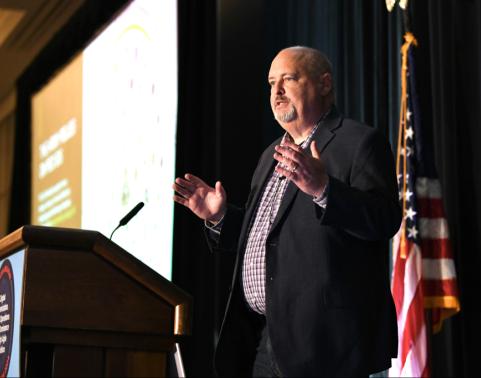ABID 2024: Hepworth previews the next phase of Agile at PEO EIS

If 2023 was the year Program Executive Office Enterprise Information Systems (PEO EIS) initiated its Agile transformation, 2024 is the year it plans to increase the maturity of its Agile delivery. This is the goal of EIS Program Executive Officer Bill Hepworth, who discussed the acquisition organization’s ongoing digital transformation — and what’s yet to come — during the final keynote address May 15 at AFCEA Belvoir Industry Days.
Hepworth recalled how PEO EIS leadership’s late 2022 preview of Agile transformation predicted EIS becoming a completely different organization firmly rooted in Agile. Hepworth said the organization has certainly achieved that goal.
“Hopefully now you’re seeing a more Agile EIS,” he said, adding that about 90% of the EIS portfolio has converted to Agile, and “we’re all delivering.”
The organization’s focus on speed, one of Hepworth’s three key pillars, is not just a personal preference. It’s a top-down priority from the Assistant Secretary of the Army for Acquisition, Logistics and Technology, which oversees all PEOs.
“Right now, with Ukraine, Israel and Taiwan, the entire ASA(ALT) community is pressed to get equipment and supplies out to partners, so we need to respond faster across the board,” said Hepworth.
To increase the speed of acquisition, EIS leaders have asked the Army Acquisition Executive to put new enterprise software programs in the Software Acquisition Pathway, as well as transition existing programs there, as appropriate. Paired with enhanced contracting strategies, Hepworth said he would be happy if acquisition lead times can be reduced to six months.
EIS is also prioritizing simplicity — Hepworth’s second pillar — by decomposing, streamlining and simplifying. EIS and its functional partners are striving to decompose large problems into smaller, solvable problems to allow a steady stream of progress.
From a software development standpoint, program teams are expediting capability delivery by conducting two-week sprints and working on features and functionality asynchronously and in parallel. The focus is to keep delivering new capability to Soldiers to continuously get feedback and refine requirements.
“Going forward, we want to get to the point where we release new code with every single build,” said Hepworth, referring to EIS’ push to implement DevSecOps pipelines.
Besides speed and simplicity, excellence is the third pillar of EIS’ digital strategy. Delivering better quality software means testing every build and providing end users with access to new code every sprint. This is only possible by using automated testing and engaging stakeholders earlier in the process.
Hepworth cited a couple of EIS programs that are on a winning path. Enterprise Business Systems – Convergence, which has extensive buy-in from its functional sponsor, is adopting the Scaled Agile Framework® (SAFe®) and is expected to put out some “real capability” beginning this fall. Hepworth also mentioned EIS’ Foreign Military Sales – Army Case Execution System, which has managed to condense its program acquisition lead time from an initially projected two years to around a year.
Hepworth credited EIS’ Global Force Information Management team for its Agile software development being “as close to West Coast as you can possibly get;” the Logistics Information Systems team for tackling the challenge of adopting Agile into an existing program; and the Integrated Personnel and Pay System – Army team for its ongoing adoption of DevSecOps and ramping up the speed of delivery to include, in some cases, nightly updates.
“We’re starting to see great dividends with teams on the same page from day one,” said Hepworth.
As always, EIS has certain expectations of industry vendors interested in partnering on enterprise software projects. One is knowledge of and demonstrated ability in SAFe methodology — Hepworth recommended that companies have at least one SAFe practitioner on staff. Another is original equipment manufacturer involvement to avoid vendor lock. Doubling down on Agile and continuous integration/continuous delivery investments is also important, said Hepworth, as EIS wants to deploy code with every build.
Another key contributor to the organization’s success is the monthly Communities of Practice — formerly known as Scrum of Scrums — initiated by Aric Sherwood and led by new Agile coach Scott Sinclair of EIS’ Acquisition Innovation Directorate. These meetings enable team members to have an ongoing dialogue about their Agile implementations and how to resolve challenges, said Hepworth.
With respect to EIS’ commitment to industry engagement, Hepworth said the organization is still working through its current backlog of meeting requests. Since January 2024, EIS has received 257 requests to convene with industry and has held 127 actual meetings. Companies are welcome to submit meeting requests via the PEO EIS website.
Related News
-
Onedia James: a logistician and leader with a family legacy of service
April 22, 2025Onedia James recently stepped into the role of acting deputy project manager for Army Data and Analytics Platforms (ARDAP) at U.S. Army Program Executive Office (PEO) Enterprise, where she helps oversee and support the data portfolio’s four programs. -
PEO Enterprise’s new PL Digital Market reimagines IT product/service procurement
April 2, 2025FORT BELVOIR, Va. – U.S. Army Program Executive Office (PEO) Enterprise today announced the launch of the Product Lead (PL) Digital Market, which replaces PL Computer Hardware, Enterprise Software and Services (CHESS), effective Apr. 2, 2025. -
Two vastly different Army programs prepare for Software Acquisition Pathway
March 24, 2025At U.S. Army Program Executive Office Enterprise, which is now over two years into its Agile transformation, several enterprise software programs are already in the execution phase of the DOD’s Software Acquisition Pathway, which is designed to facilitate rapid and iterative delivery of software capability to users.
Work for Us
Join a winning team! Search for job opportunities with PEO Enterprise.
Work with Us
Help support important missions. Explore ways your company can work with PEO Enterprise.